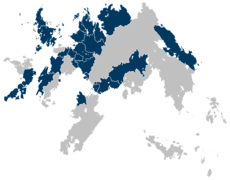Assembly of Nations: Difference between revisions
No edit summary |
No edit summary |
||
| Line 40: | Line 40: | ||
|leader_title4 = [[Assembly of Nations#Structure|Security Council President]] | |leader_title4 = [[Assembly of Nations#Structure|Security Council President]] | ||
|leader_name4 = X | |leader_name4 = X | ||
|established_event1 = [[ | |established_event1 = [[Treaty of Lehpold]] signed | ||
|established_date1 = 10 March 1917 | |established_date1 = 10 March 1917 | ||
|established_event2 = Charter ratified | |established_event2 = Charter ratified | ||
|established_date2 = | |established_date2 = 1 December 1917 | ||
|established_event3 = First Great Council meeting | |established_event3 = First Great Council meeting | ||
|established_date3 = 1 January 1920 | |established_date3 = 1 January 1920 | ||
| Line 49: | Line 49: | ||
}} | }} | ||
The '''Assembly of Nations''' ('''AN''' or sometimes '''AoN''' or '''AON''') is an {{wp|intergovernmental organization}} established to provide and maintain international peace and security, developing close relations among member states, achieving widespread international co-operation, and being a forum for the diplomatic interaction between nations. It was founded after the [[Continental War (Gaia)|Continental War]] during the [[ | The '''Assembly of Nations''' ('''AN''' or sometimes '''AoN''' or '''AON''') is an {{wp|intergovernmental organization}} established to provide and maintain international peace and security, developing close relations among member states, achieving widespread international co-operation, and being a forum for the diplomatic interaction between nations. It was founded after the [[Continental War (Gaia)|Continental War]] during the [[Treaty of Lehpold]], with its aim of preventing any future wars on the scale of the Continental War, and evolved into an organization dealing with maintaining international peace and security, protecting human rights, providing {{wp|humanitarian aid}}, promoting {{wp|sustainable development}}, and upholding international law. Its [[Assembly of Nations#Structure|headquarters]], with all AN territories as subjects to a status of {{wp|extraterritoriality}}, are in [[Köpenick]], [[Königsreh]], and it has other main offices in [[Krasno]], X. | ||
The AN is the largest, most familiar, most internationally represented and most powerful intergovernmental organization in the world. At its founding, the AN had X [[Assembly of Nations#Member states|member states]]. As of 2019, there are now 20. | The AN is the largest, most familiar, most internationally represented and most powerful intergovernmental organization in the world. At its founding, the AN had X [[Assembly of Nations#Member states|member states]]. As of 2019, there are now 20. | ||
Revision as of 16:47, 5 March 2020
Assembly of Nations | |
|---|---|
 Map showing the members states of the Assembly of Nations | |
| Headquarters | Köpenick, Königsreh (international territory) |
| Official languages | |
| Type | Intergovernmental organization |
| Membership | 16 member states |
| Leaders | |
| X | |
| X | |
| X | |
| X | |
| Establishment | |
• Treaty of Lehpold signed | 10 March 1917 |
• Charter ratified | 1 December 1917 |
• First Great Council meeting | 1 January 1920 |
Website www.an.org www.an.int | |
The Assembly of Nations (AN or sometimes AoN or AON) is an intergovernmental organization established to provide and maintain international peace and security, developing close relations among member states, achieving widespread international co-operation, and being a forum for the diplomatic interaction between nations. It was founded after the Continental War during the Treaty of Lehpold, with its aim of preventing any future wars on the scale of the Continental War, and evolved into an organization dealing with maintaining international peace and security, protecting human rights, providing humanitarian aid, promoting sustainable development, and upholding international law. Its headquarters, with all AN territories as subjects to a status of extraterritoriality, are in Köpenick, Königsreh, and it has other main offices in Krasno, X.
The AN is the largest, most familiar, most internationally represented and most powerful intergovernmental organization in the world. At its founding, the AN had X member states. As of 2019, there are now 20.
History
Structure
Membership
Member states
| Flag | Country | Date of admission | Further role in the AN |
|---|---|---|---|
| Alriika | X | ||
| Arlyon | X | ||
| Ashihara | X | ||
| Brilliania | X | ||
| Crethia | X | ||
| Dulebia | X | ||
| Finium | X | ||
| Hytekia | 21 August 2003[1] | ||
| Juznia | 21 August 2003[1] | ||
| Krumlau | 10 March 1917 | ||
| Lavaria | X | ||
| Lilienburg | 10 March 1917 | ||
| Mascylla | 10 March 1917 | ||
| Oseva | X | ||
| Penntia | X | ||
| Svaldheim | X | ||
| Tuskval | X | ||
| Velsken | X | ||
| Vetonia | X |
- ↑ 1.0 1.1 The People's State of Hytekojuznia joined the Assembly of Nations in 1917.

